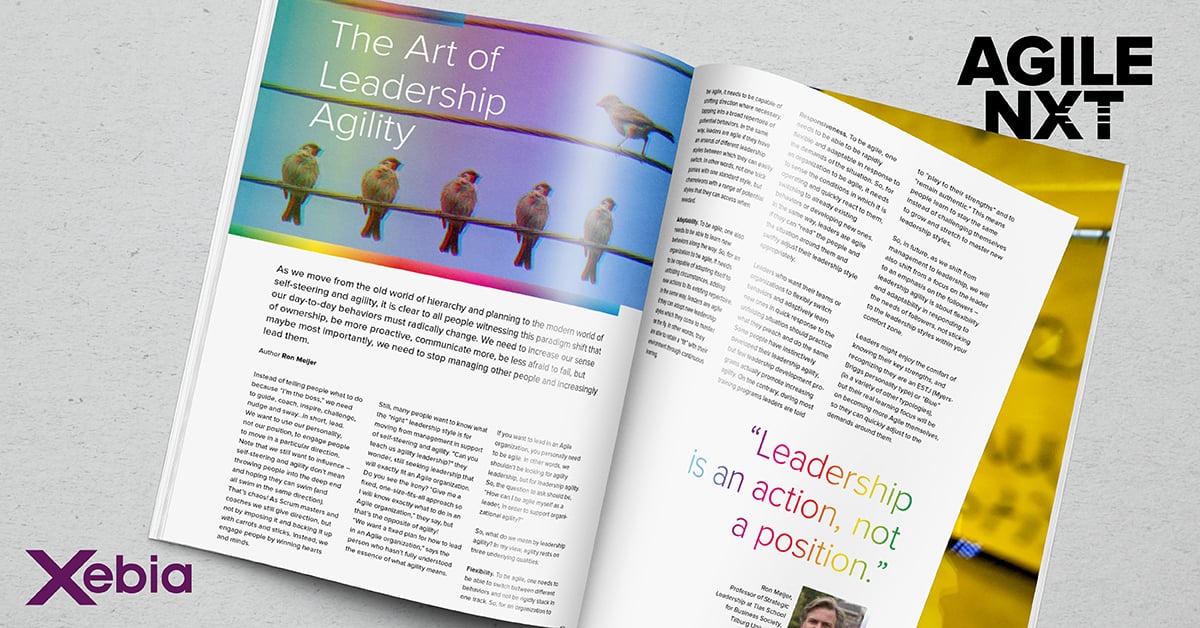As we move from the old world of hierarchy and planning to the modern world of self-steering and agility, it is clear to all people witnessing this paradigm shift that our day-to-day behaviors must radically change. We need to increase our sense of ownership, be more proactive, communicate more, be less afraid to fail, but maybe most importantly, we need to stop managing other people and increasingly lead them.
Instead of telling people what to do because “I’m the boss,” we need to guide, coach, inspire, challenge, nudge and sway…in short, lead. We want to use our personality, not our position, to engage people to move in a particular direction. Note that we still want to influence – self-steering and agility don’t mean throwing people into the deep end and hoping they can swim (and all swim in the same direction). That’s chaos! As Scrum masters and coaches we still give direction, but not by imposing it and backing it up with carrots and sticks. Instead, we engage people by winning hearts and minds.
This article is published in  . Agile NXT is a new magazine full of inspiration for professionals on the emerging Agile journey. It challenges you to think differently and improve yourself, your team, and company a little more each day.
. Agile NXT is a new magazine full of inspiration for professionals on the emerging Agile journey. It challenges you to think differently and improve yourself, your team, and company a little more each day. 
Still, many people want to know what the “right” leadership style is for moving from management in support of self-steering and agility. “Can you teach us agility leadership?" they wonder, still seeking leadership that will exactly fit an Agile organization. Do you see the irony? “Give me a fixed, one-size-fits-all approach so I will know exactly what to do in an Agile organization,” they say, but that’s the opposite of agility!
“We want a fixed plan for how to lead in an Agile organization,” says the person who hasn’t fully understood the essence of what agility means.
If you want to lead in an Agile organization, you personally need to be agile. In other words, we shouldn’t be looking for agility leadership, but for leadership agility. So, the question to ask should be, “How can I be agile myself as a leader, in order to support organizational agility?”
So, what do we mean by leadership agility? In my view, agility rests on three underlying qualities:
Flexibility. To be agile, one needs to be able to switch between different behaviors and not be rigidly stuck in one track. So, for an organization to be agile, it needs to be capable of shifting direction where necessary, tapping into a broad repertoire of potential behaviors. In the same way, leaders are agile if they have an arsenal of different leadership styles between which they can easily switch. In other words, not one trick ponies with one standard style, but chameleons with a range of potential styles that they can access when needed.
Adaptability. To be agile, one also needs to be able to learn new behaviors along the way. So, for an organization to be agile, it needs to be capable of adapting itself to unfolding circumstances, adding new actions to its existing repertoire. In the same way, leaders are agile if they can adopt new leadership styles which they come to master
on the fly. In other words, they are able to retain a “fit” with their environment through continuous learning.
Responsiveness. To be agile, one needs to be able to be rapidly flexible and adaptable in response to the demands of the situation. So, for an organization to be agile, it needs to sense the conditions in which it is operating and quickly react to them, switching to already existing behaviors or developing new ones. In the same way, leaders are agile if they can “read” the people and the situation around them and swiftly adjust their leadership style appropriately.
Leaders who want their teams or organizations to flexibly switch behaviors and adaptively learn
new ones in quick response to the unfolding situation should practice what they preach and do the same. Some people have instinctively developed their leadership agility, but few leadership development programs actually promote increasing agility. On the contrary, during most training programs leaders are told to “play to their strengths” and to “remain authentic." This means
people learn to stay the same instead of challenging themselves to grow and stretch to master new leadership styles.
So, in future, as we shift from management to leadership, we will also shift from a focus on the leader to an emphasis on the followers – leadership agility is about flexibility and adaptability in responding to the needs of followers, not sticking to the leadership styles within your comfort zone.
Leaders might enjoy the comfort of knowing their key strengths, and recognizing they are an ESTJ (Myers-Briggs personality type) or “Blue” (in a variety of other typologies), but their real learning focus will be on becoming more Agile themselves, so they can quickly adjust to the demands around them.
Want to know more about Agility and Leadership? Download  and start your personal change tomorrow.
and start your personal change tomorrow.






